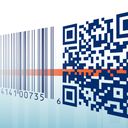QR-style "2D barcodes" will revolutionize retail as we know it

The humble and familiar barcode — a staple on consumer packaging for nearly 50 years — will soon be replaced with a more robust and muscular successor that offers far more information about the product inside.
- The new "2D" barcodes will unlock reams of online extras (for consumers) and revolutionize inventory management (for retailers).
- Scanning them may tell us the field where something was grown, the factory where a garment was sewn, the sustainability practices of the company that made it — or the washing instructions.
Why it matters: The technology promises to improve product safety, give us greater transparency into the origins of the items we buy, and enhance our lives with handy suggestions about how to use or prepare our purchases.
- Stores will be able to respond immediately to product recalls, identifying faulty items and removing them from shelves.
- They'll be able to flag foods that are approaching their sell-by date — and offer discounts before they expire.
- Consumers will gain online access to a trove of useful data — everything from ingredients, recipes and potential allergens to promotional offers and information about how to recycle the product.
Driving the news: In a worldwide push called "Sunrise 2027," the retail industry is transitioning from the standard 12-digit barcode — that square of vertical lines that's printed on a package and makes it go "beep" at the checkout scanner — to a two-dimensional web-enabled version.
- The effort is being orchestrated by GS1 US, the nonprofit standards organization that oversees the barcode world.
- In the United States, Universal Product Code (UPC) barcodes will be supplanted by a new 2D type, with information encoded on both the horizontal and vertical axes.
How it works: In contrast to the lowly UPC barcode — a barebones workhorse printed on virtually every consumer product in the world — the 2D upgrades will "take you on an experience that the brand wants you to have," says Carrie Wilkie, SVP of standards and technology at GS1 US.
- Products will still scan the same way at the cash register, but the souped-up barcodes will open up a world of real-time frills — such as loyalty points, games and coupons.
- "The mechanics of being able to encode on both dimensions of that square QR code give you the ability to put more robust information than you can today in a UPC that can only hold a small amount of numbers," Wilkie tells Axios.
- We grew familiar with one type of 2D barcode during the COVID-19 pandemic: QR codes, which are now ubiquitous gateways to restaurant menus.
On the back end, stores expect huge improvements in inventory control to spring from the 2D upgrades.
- "As brands and retailers make more investments in AI and robotics, they need that in a machine-readable format," Wilkie says.
Where it stands: Puma is the first company to announce that it's using 2D barcodes in its U.S. stores and products, Wilkie said.
- Those codes link to information about Puma's sustainability efforts and the materials in the sneakers you're buying.
- Internationally, 2D barcodes are being used in Australia and New Zealand for freshness information about deli and meat products.
- In Japan, a retailer is using them to do "on-demand discounting" of foods with fewer than three days of remaining shelf life.
Backstory: The first item marked with a UPC was scanned on June 26, 1974, at Marsh Supermarket in Troy, Ohio, per Smithsonian Magazine.
- Clyde Dawson, the supermarket's head of R&D, pulled a multi-pack of Wrigley's Juicy Fruit from his shopping cart and gave it to cashier Sharon Buchanan to scan.
- "He chose it because nobody had been sure that a bar code could be printed on something as small as a pack of chewing gum," reads the story.
What's next: GS1 US just released a "barcode capabilities test kit" to help retailers evaluate their readiness for the 2D transition.
- We can expect to start seeing more products printed with 2D barcodes (or both types, as the transition moves forward) fairly soon.